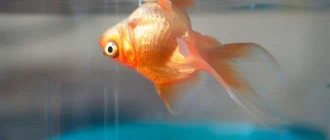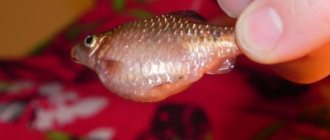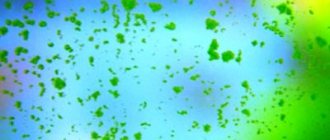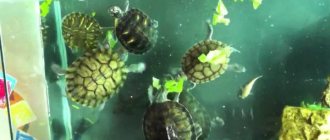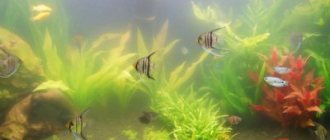Unfortunately, like other living things, fish can die before their due date. Why is this happening? Beginning aquarists often seek the answer to this question. It is much more effective to prevent the occurrence of such a problem than to later look for the reasons for the death of a pet.
An ideal option if you asked yourself this question before the tragedy occurred. Being warned means being ready to control all the nuances of the aquarium and try to avoid the early death of aquarium inhabitants. Let's look at the most common reasons.
Nitrogen poisoning
Nitrogen poisoning is the most common problem. It often concerns beginners who have no experience in dealing with aquarium animals. The fact is that they try to feed their pets to their fullest, forgetting that at the same time the amount of waste increases. According to the simplest calculations, each fish leaves excrement equal to 1/3 of its weight per day. However, not everyone knows that in the process of oxidation and decomposition, nitrogen compounds appear, consisting of:
- Ammonium,
- Nitrates,
- Nitrites.
All these substances have in common their toxicity. The most dangerous of them is considered to be ammonium, an excess of which will be the main cause of death of all inhabitants of the reservoir. This happens most often in recently launched aquariums. It is the first week after the start that becomes critical. There are two options for increasing the amount of these substances in aqua:
- Increase in the number of residents,
- Filter failure,
- Excessive amount of feed.
You can determine the excess by the state of the water, more precisely by the smell and color. If you notice darkening of the water and a rotten smell, then the process of increasing ammonium in the water has begun. It happens that upon visual inspection, the water in the fish house is crystal clear, but the smell makes you wonder. To confirm your suspicions, ask for special chemical tests at pet stores. With their help, you can easily measure the level of ammonium. True, it is worth noting the high cost of the tests, but for a novice aquarist they are very necessary if you do not want to lose all your pets in a couple of days. If the situation is corrected in time, a fatal outcome can be avoided.
How to lower ammonia levels:
- Daily ¼ water change
- The water must stand for at least a day,
- Checking the filter and filter element for serviceability.
What to do if you find a dead fish
Death does not occur for no apparent reason. You can determine what caused it by external inspection. If you find dead fish in the aquarium, you should:
- Remove dead body. If this is not done in time, decomposition and poisoning of the aquatic environment and its inhabitants will begin.
- Assess the integrity of scales, fins and tail, the appearance of the belly and eyes. An examination may indicate that she was injured by neighbors, poisoning or illness.
- Check the water using tests. Drip tests will provide an accurate result; they are the ones you should pay special attention to. Perhaps the content of ammonia and other harmful substances in the water is exceeded.
- Inspect the aquarium and count the number of inhabitants, make sure that they are all healthy.
Incorrect launch of fish
Imagine what a fish experiences when it gets from one water to another, the parameters of which are significantly different. When you buy a fish at a pet store, you deprive it of its usual environment, transferring it to your own, which is completely unfamiliar to the fish. Water differs in hardness, temperature, acidity, etc. Of course, the reaction to such a change will be stress. A sharp change in acidity by even 1 unit means death for sensitive fish. Sometimes the difference in acidity is much greater, so the shock that the fish experiences can be fatal.
Correct adaptation of fish to a new environment:
- Pour the water along with the fish into a large vessel,
- Add some water from the general aquarium,
- After 10-15 minutes, repeat the procedure,
- Dilute the water to at least 70% solution.
Even if several new fish managed to survive after a devastating change in water parameters, they will certainly die with the first illness. The immune system is significantly weakened, which means that bacteria attack them first. Keep a close eye on aeration, cleanliness and new residents. At best, the health of the fish returns to normal.
Prevention
In most cases, fish die in an aquarium due to the inattention and careless attitude of the owner. Every day you need to count the number of fish and monitor their interaction, siphon the soil once every 1-2 weeks, and change the water if necessary. The aquarist’s task is to do everything for the full life of the fish and respond in a timely manner to changes occurring in the aquarium.
Previous
AquariumTips for choosing stones for an aquarium
Next
AquariumIs it enough for an aquarium to sit for just a few hours?
Fish diseases
No one wants to blame themselves, so novice breeders blame illness for everything. Unscrupulous sellers only reinforce their doubts, since their goal is to sell expensive medicine and make money. However, do not rush for a panacea; carefully study all possible causes of death.
Diseases can only be blamed if the symptoms have been present for a long time. The fish faded away gradually, and did not just die in an instant, for no apparent reason. Most often, the disease is brought into the aquarium along with new residents or plants. Death can occur due to a malfunctioning heating element in cold weather.
When going to pet stores, you must be aware of what exactly you need medicine for. Each drug is aimed at a specific disease. There are no universal cures! If possible, consult with an experienced aquarist or on a forum; knowledgeable people will tell you what to do in such a situation.
Of course, disease cannot kill healthy fish. Why do fish die in an aquarium? If death occurs, it means that immunity has already been undermined. Most likely, the first two errors occurred. Do not rush to launch new residents, no matter how beautiful they are.
What to do to protect your aquarium:
- Organize quarantine for new residents,
- Sanitize your fish or plants.
What to do if there is a disease in the aquarium:
- Change a tenth of the water daily,
- Increase the temperature
- Increase aeration
- Remove disease carriers and those who are clearly infected.
Remember what kind of fish you launched at home last. Individuals brought from other countries can be carriers of rare diseases, which are sometimes not possible to detect and classify on their own.
Semolina
Another very widespread disease of freshwater aquarium fish, and ancistrus in particular, is, as it is popularly called, semolina. This disease gets its name because white spots appear on the body of the diseased fish, which are very similar to warts. Their fraction is exactly the same as that of semolina. In science, this disease is called ichthyophthyriosis. Ichthyophthiriasis will occur at least once in every aquarium. No one is safe from it. This disease can only be brought into the aquarium from the outside, so when buying fish at a pet store, do not believe the fairy tales of sellers that all their fish undergo disinfection and quarantine.
The causative agent of this disease is the ciliate “ichthyophthirius”. This is one of the most common parasites in fish. The white dots that are visible on the fish are pockets of the host epithelium containing ciliate cells called trophonts or trophozoites. After 6-7 days of parasitism on fish, the adult trophozoid parts with its host, settles to the bottom and secretes a cyst. The cell inside it undergoes emergency division and after 24 hours the light will see from 600 to 1000 daughter cells. And then new cells infect new fish. The full development cycle lasts from 7 to 10 days. You can get rid of ichthyophthyriosis chemically using: formalin; malachite green; copper sulfate; potassium permanganate.
These drugs, when used in a community aquarium, can damage plants and lead to the death of invertebrates, such as snails. After the white dots disappear from the fish’s bodies, treatment still needs to be carried out for several days to kill all the infection that is still floating in the water column. This usually lasts about a week. Treatment is carried out at a temperature of 27 degrees Celsius for 10 days, and 6 days at a temperature of 29 degrees. Be careful when handling malachite green. This drug is dangerous and is one of the causes of cancer. It can also cause mutations and is dangerous for newborns. When working with this substance, you must wear a mask and gloves. Pregnant women are contraindicated to use this drug.
THE TWO MOST COMMON DISEASES OF FRESHWATER AQUARIUM FISH
BRANCHIOMYCOSIS: TREATMENT, SYMPTOMS, DESCRIPTION.
Water quality
Utility services do not set themselves the task of purifying the water to such an extent that aquarium residents feel comfortable. Their goal is to make it safe for people and their homes. This is where the popularity of bottled water comes from. Tap water contains maximum levels of chlorine. In large cities, there may be a possibility of a change in water from artesian to desalinated water. As a result, water hardness will increase, which will lead to mass death. You can notice this by the changed behavior of the fish - they begin to rush around the entire aquarium in a state of horror.
O2 deficiency
This option is the rarest of all. The oxygen saturation of a fish house is always adequately assessed even by novice aquarists. The first thing everyone does is buy a compressor. With it there is no fear of fish suffocating.
The only possible option is an increase in temperature and, as a result, a decrease in oxygen in the water. This can happen at night, when plants switch from producing oxygen to absorbing it. To avoid this, do not turn off the compressor at night.
Aggressive neighbors
Before you go to the store for pets, think through to the smallest detail: will several species be able to get along in one fish house? You should not count on the seller’s competence, since his main goal is to sell as much product as possible.
A few fundamental rules:
- Big fish always try to eat small ones (even in the case of herbivorous species),
- Many succumb to intraspecific aggression,
- Some know how to attach themselves to small neighbors, which ultimately turns into death,
- The strong always eat the weak
- Buy only those fish that you are sure are peaceful.
Unfortunately, it is impossible to determine why the fish are dying. The death of a pet can happen even among experienced breeders. Treat your fish carefully, and you will definitely notice a change in behavior and eliminate the cause of concern in time. More often than not, fish die in an aquarium due to oversight, and not due to other criteria.
Hello, dear friends!
Many newbie aquarium keepers very often ask why they die, although, in their opinion (I mean, in the eyes of beginners) they do everything correctly, according to the book. In this article I will try to highlight the most common mistakes that beginners make. So!
1) The first thing that beginners don’t pay attention to is the recommended water parameters! Friends! Hard and soft water are as different from each other as white and black! And if you put a fish in water that is unacceptable for it, then consider your fish dead! Therefore, I strongly recommend that you strictly follow the recommendations for maintaining water parameters!
2) The second common mistake is ignoring the water temperature. Beginners believe that a difference of one or two degrees does not play a big role for fish. How they play! Guys, fish are not people, they are so sensitive to water that you can’t even imagine! Therefore, for them, “plus” or “minus” two degrees is as noticeable as for you and me +10*C or -10*C! Keep this in mind and then you will have much less problems!
3) The third mistake is neglecting the aquarium lighting. The fact is, friends, that for most tropical fish the daylight hours last 10 - 12 hours. Our daylight hours are somewhat shorter, especially in winter. And if the fish does not receive enough light, then its biological clock will simply break. And since a fish is a fragile creature, death follows such a breakdown. Keep this in mind for the future!
4) Another reason for the frequent death of fish is the incompatibility of species. And this applies not only to carnivorous and herbivorous fish. There is also the factor of nitrogen tolerance. For example, if some fish do not react in any way to an increase in nitrogen concentration, then others die from acute nitrogen poisoning! There is only one piece of advice in this case: study the characteristics of each species before combining them in one aquarium!
5) And here is another reason - overpopulation of the aquarium! Quite often, newcomers are accommodated in one small apartment. Plus they also throw in plants the size of a cubic meter! The result is overpopulation, lack of oxygen, and - hello! Here's an unspoken rule for you, friends: at least 3 liters of water per fish! And this is for the smallest one! Depending on the size, the displacement increases. Consider this factor too!
6) Improper feeding is also a common cause of mass death of fish. For some reason, beginners think that all they have to do is throw a pinch of dry food into the aquarium and that’s it! This is absolutely wrong! Fish should eat a varied diet! And if they eat only dry food, they will very soon die from inflammation of the stomach and intestines: dry food is very difficult to digest! Diversify your fish's menu: give them dry food, live food, and plant food! For example, many fish love lettuce leaves, which need to be chopped.
Reproduction and feeding
The stimulus for reproduction is a change in water or a deviation from optimal temperature parameters.
The spawning period lasts 4–5 days. The female takes milk from the male into her mouth. At the same time, she lays several eggs in the pelvic fins, folded in the form of a scoop. Having chosen places on the walls of the aquarium or the leaves of plants, she lubricates them with milk and glues the eggs, which ripen in 5–6 days. During one spawning, the female lays up to 200 eggs. The fry grow up to 1 cm in 1 month, and reach maturity by 8 months of age.
As food, you can use large (so that it sinks to the bottom) plant and live (bloodworms, coretra, tubifex) food, as well as granular or in the form of tablets for bottom fish.
The most common diseases of catfish are ichthyophthyriosis with an associated bacterial infection.
Warnings
- Do not throw out the fish until you are sure that it is dead.
- Don't wait too long to throw away your fish. Dead fish are carriers of infection, which they can fill the water with and infect other fish.
- NEVER flush fish down the toilet. Not only is it harmful to the environment, but it also spreads tropical infections to non-tropical areas. Bury them or throw them in the trash. If the fish is large, it is best to bury it, if permitted by law.
If only one fish dies in the aquarium, and the water looks clean, it is not necessary to change it, since after changing the water you will need to wait for the ecosystem and biological balance to be restored. Therefore, it is enough to simply add fresh water, renewing the old one. If the fish has died from an infectious disease or has been in the aquarium for several days, the water should be replaced and the aquarium washed out.
When adding fresh water, at least one third of the old water should remain in the aquarium - and the fresh water should have similar hardness and temperature.
If the aquarium still needs to be cleaned, you need to remove all live fish and plants from it, wash, disinfect and dry. After this, new water is poured into the container. In the first few days, a short-term bacterial outbreak with cloudy water may occur in the aquarium - no need to worry, it will go away on its own. After this, when the water becomes clear again, the plants can be returned to the aquarium, and it is advisable to introduce the fish after about a week. Changing the water is often the most effective way to get rid of bacteria, but it is a huge stress for the fish, so you shouldn’t overuse it.

